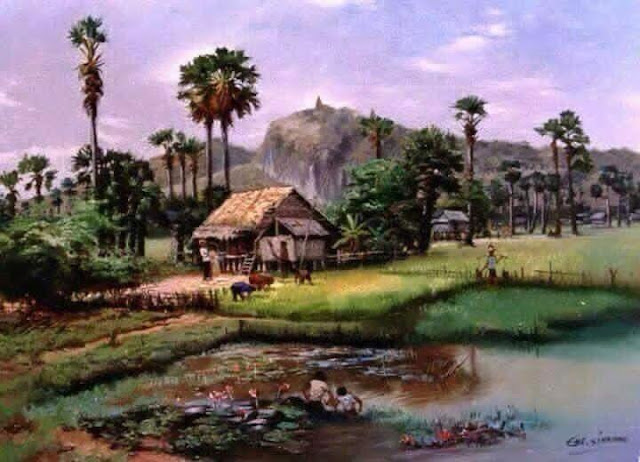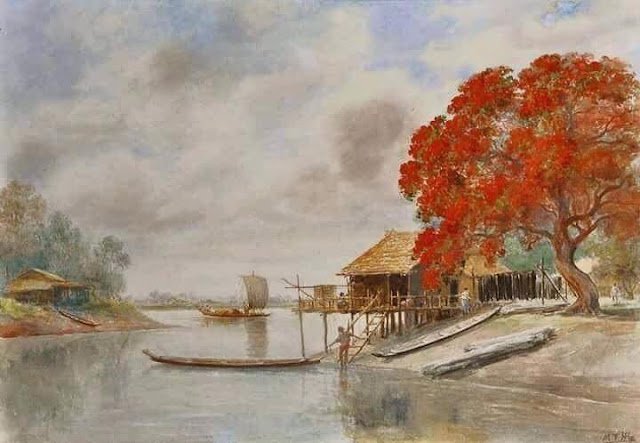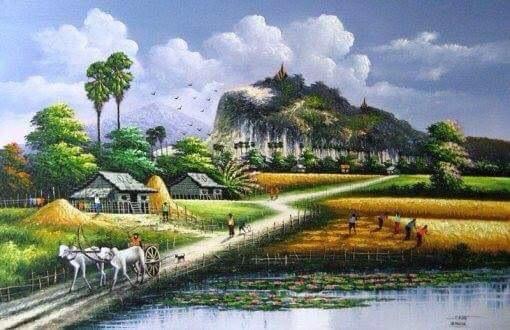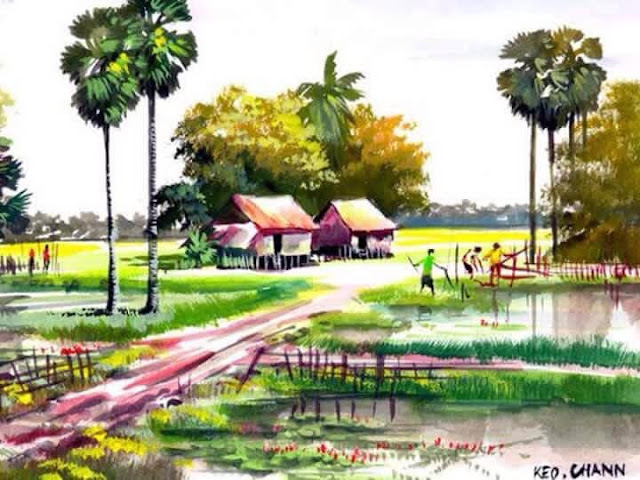Khmer home and landscape paintings of the Khmer peopleគំនូរខ្មែរអំពីផ្ទះ និង ទេសភាព នៃ ប្រជាជនខ្មែរ
Like the other early people groups of Southeast Asia, for example, the Pyu, Mon, Cham, Malay and Javanese, the Khmer were impacted by Indian society and researchers, embracing their religions, sciences, and traditions and acquiring from their dialects. The main effective exchanging kingdom in Southeast Asia, the Kingdom of Funan, was built up in southeastern Cambodia and the Mekong Delta in the first century CE, albeit broad archeological work in Angkor Borei close to the present day Vietnamese fringe has uncovered brickworks, waterways, burial grounds and graves dating to the fifth century BCE. The Kingdom of Funan is thought to be the mother of all later Southeast Asian kingdoms. Amid the Funan period (first century - 6th century CE) the Khmer likewise gained Buddhism, the idea of the Shaivite Deva Raja (God-King) and the considerable sanctuary as a typical heavenly mountain. An adversary Khmer kingdom, Chenla rose in the fifth century, and later vanquished the Funan. Chenla was an upland express whose economy was dependent on farming while Funan was a swamp state with an economy reliant on oceanic exchange. These two states, even after triumph by Chenla in the 6th century, were continually at war with one another and littler territories. Amid the Chenla period (fifth century - eighth century CE) Cambodians left the world's most punctual known zero in one of their sanctuary engravings. Just when King Jayavarman II proclaimed an autonomous and united Cambodia in 802 CE arrived relative peace between the two terrains, upper and swamp Cambodia. Jayavarman II (802–830), resuscitated Cambodian control and manufactured the establishment for the Angkorean realm, establishing three capitals—Indrapura, Hariharalaya, and Mahendraparvata—the archeological stays of which uncover much about his times. In the wake of winning a long thoughtful war, Suryavarman I (ruled 1002–1050) turned his strengths eastbound and enslaved the Mon kingdom of Dvaravati. Hence, he led over most of present-day Thailand and Laos, and also the northern portion of the Malay Peninsula. This period, amid which Angkor Wat was developed, is viewed as the zenith of Khmer human p
Like the other early people groups of Southeast Asia, for example, the Pyu, Mon, Cham, Malay and Javanese, the Khmer were impacted by Indian society and researchers, embracing their religions, sciences, and traditions and acquiring from their dialects. The main effective exchanging kingdom in Southeast Asia, the Kingdom of Funan, was built up in southeastern Cambodia and the Mekong Delta in the first century CE, albeit broad archeological work in Angkor Borei close to the present day Vietnamese fringe has uncovered brickworks, waterways, burial grounds and graves dating to the fifth century BCE. The Kingdom of Funan is thought to be the mother of all later Southeast Asian kingdoms. Amid the Funan period (first century - 6th century CE) the Khmer likewise gained Buddhism, the idea of the Shaivite Deva Raja (God-King) and the considerable sanctuary as a typical heavenly mountain. An adversary Khmer kingdom, Chenla rose in the fifth century, and later vanquished the Funan. Chenla was an upland express whose economy was dependent on farming while Funan was a swamp state with an economy reliant on oceanic exchange. These two states, even after triumph by Chenla in the 6th century, were continually at war with one another and littler territories. Amid the Chenla period (fifth century - eighth century CE) Cambodians left the world's most punctual known zero in one of their sanctuary engravings. Just when King Jayavarman II proclaimed an autonomous and united Cambodia in 802 CE arrived relative peace between the two terrains, upper and swamp Cambodia. Jayavarman II (802–830), resuscitated Cambodian control and manufactured the establishment for the Angkorean realm, establishing three capitals—Indrapura, Hariharalaya, and Mahendraparvata—the archeological stays of which uncover much about his times. In the wake of winning a long thoughtful war, Suryavarman I (ruled 1002–1050) turned his strengths eastbound and enslaved the Mon kingdom of Dvaravati. Hence, he led over most of present-day Thailand and Laos, and also the northern portion of the Malay Peninsula. This period, amid which Angkor Wat was developed, is viewed as the zenith of Khmer human p


































































0 comments:
Post a Comment